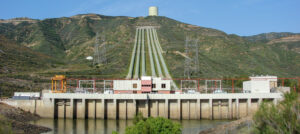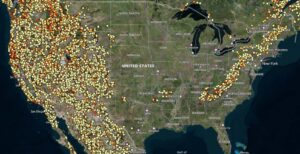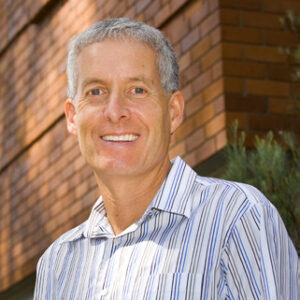Seeking to enable a massive increase in energy storage capacity, researchers at the Australian National University (ANU) recently carried out a survey of the entire surface of the globe for potential pumped hydro sites. The number of sites they found may surprise you. Hydro Leader spoke with project lead Andrew Blakers about what the team discovered. His message to the world: Mass storage is a solved problem. Develop your wind and solar now, because the vast untapped potential of off-river pumped hydro storage makes transitioning to 100 percent renewables feasible at low cost.
Hydro Leader: Please tell us about your background and how you came to be in your current position.
Andrew Blakers: I’m a professor of engineering at ANU. I got a degree in physics and math and then a PhD in solar photovoltaic technology, specifically silicon solar cells. For several decades, I worked mainly at the University of New South Wales and ANU on high-performance silicon solar cells. Starting about a decade ago, it became obvious that solar was going to take over the world. It was also obvious that it couldn’t do that unless there was adequate energy storage, in particular overnight storage. Batteries, at the time, were prohibitively expensive, so pumped hydro was the primary option. Most pumped storage sites are on rivers, but I was strongly engaged in environmental protection, and since damming all the rivers in sight sounded like a bad idea, I started looking at off-river sites. These days, I spend most of my time on 100 percent renewable energy futures, looking at solar, wind, and pumped hydro.
Hydro Leader: Please introduce ANU and the engineering department you work in.
Andrew Blakers: ANU is typically rated the number 1 or number 2 university in Australia. Our engineering department has about 60 researchers, with a small number working in 100 percent renewable energy futures. Another 40 or 50 people work in allied areas, such as thermal energy and the grid integration of batteries. I should mention that during the 1980s at the University of New South Wales, Martin Green and I developed the passivated emitter rear contact, or PERC, silicon solar cell, which currently accounts for 90 percent of the global market and has cumulative global sales of about $100 billion to date. Australian technology is deeply embedded in practically every solar module sold around the world today because the Australian solar industry has been at the forefront of technical development since the early 1970s.

Hydro Leader: What was the motivation for your pumped hydro energy storage project?
Andrew Blakers: When I began looking at 100 percent renewable energy futures, based mostly on solar and wind generation with a bit of existing hydro and bio energy, it was obvious that we needed overnight storage of durations of 4–40 hours. It was also obvious that you could get that by damming more rivers, but then you’d come up against formidable environmental and social pushback. We decided to look at the 99 percent of the world’s land surface that is not near a river, excluding national parks and World Heritage areas. For off-river pumped hydro, you need an upper and lower reservoir separated by a few kilometers in space, with a height difference of 100–1,000 meters. That requirement is met wherever there are hills.
To search for potential sites, we conducted a GIS survey of the entire world, excluding polar regions. The survey pixel size was about 30 meters square, and our computer program crawled over every pixel, putting a test dam on it to see whether it had a reasonable water-to-rock ratio. We came up with an enormous number of potential sites. We applied a cost model to each of them and then discarded almost all of them, keeping about 616,000 of the best sites.
Hydro Leader: How many people worked with you on this project?
Andrew Blakers: About three or four. We developed various algorithms for searching the world. The program was initially slow—it was going to take a supercomputer several months to run. Then, it turned out that the son of one of the team members was very good at the C programming language. He converted it into a fast algorithm that allowed us to crawl over the entire surface of the world on a PC in a few days.
Hydro Leader: What factors, besides geographic ones, did you consider in determining whether a potential site was viable?
Andrew Blakers: Because the reservoirs typically have rockfill dam walls, the three important parameters to gauge the cost of these systems are head; average slope, which is head divided by spatial separation; and the water-to-rock ratio. The water-to-rock ratio is the amount of water that you can impound relative to the amount of rock you have to move to create the dam walls. Those three numbers can pretty much tell you what the cost of an off-river pumped hydro site will be.
Hydro Leader: Is the availability of fill water also a major factor?
Andrew Blakers: Fill water is a trivial issue in most places, and I can explain why. We conducted hour-by-hour studies over many years for 100 percent renewable energy systems. This means that we looked at solar, wind, and electricity demand data for every hour of the year for 5, 10, or 15 years. We looked for solutions that provided enough solar and wind to ensure that there was no hour when demand exceeds supply. To make a solution like that work, we must put energy into mass storage, and we must also interconnect widely spaced regions with high-voltage transmission. We then added up the amount and cost of transmission, solar, wind, and storage. The lowest-cost solutions typically involve 70 percent of the money going into solar and wind generation and 30 percent going into balancing, which includes storage; transmission to smooth out local weather and demand; and curtailment, which refers to the spilling of energy when storage is full and wind and solar energy is still being generated. We know how much storage we need in an advanced country like Australia or Japan, and we divide that amount by the population to work out how much water per person is required for the initial fill and, if necessary, to replace evaporation.
It turns out that if you build these systems over 25 years as you transition from predominantly coal- or gas-based generation to nearly 100 percent renewables, you need about 4 liters per person per day, both for the initial fill and later on to replace evaporation. That’s about 30 seconds of an average morning shower. According to our calculations, even if you had to deliver that water by truck, it would only add a few percent to the capital cost of your pumped storage system.
We also know that land is not an issue, because it turns out that you only need about 3 square meters of pumped hydro reservoir per person to support a 100 percent renewable electricity system. That’s about the area of a queen-size bed.
Hydro Leader: Were you surprised by the number of sites you discovered?
Andrew Blakers: We were not surprised by the results. Australia is flat and arid, and even here we found hundreds of sites in our test runs. When we surveyed the whole world and discovered 616,000 sites, the number sounded right. In fact, there are hundreds of millions of potential sites, but our cost model led us to get rid of all but 616,000. Having gathered 616,000 sites, we ranked them using our cost model into classes A, B, C, D, and E, where class E sites cost about twice as much per unit of energy storage as class A sites.
Hydro Leader: Have you seen more off-river pumped hydro sites being developed since you published your results?

Andrew Blakers: Our goal is to save the world from severe climate change, and storage is an important component of that. We are always keen to work with governments, companies, and the general public to let them know that storage is not a problem. Solar and wind can be built with a high degree of confidence that a well-known, off-the-shelf solution for storage exists—namely, pumped hydro. Sites are available in nearly every country in vast numbers. You don’t have to wait around and talk about future cost reductions. So go ahead and build your solar and wind now.
We’ve had strong buy-in in our home country of Australia. Malcolm Turnbull, the prime minister of Australia from 2015 to 2018, picked up our work. The direct result was the construction of the Snowy 2.0 pumped hydro system, which is not off-river but is what we call a bluefield system. It connects two existing reservoirs with an underground tunnel. It has 350 gigawatt-hours of energy storage and 2 gigawatts of power, which makes it bigger than all the utility batteries in the whole world put together. Within a year of the release of our findings in 2017, we changed the view among politicians and business leaders that hydro had no future in Australia.
That major investment is not surprising: Australia is the global pathfinder for solar and wind deployment. Australia is installing solar and wind two to three times faster per capita than the United States and three to five times faster than China, Japan, and the European Union. Australia generates about twice as much solar energy per person as the next-most-solarized countries with gigawatt-scale grids: the Netherlands, Germany, and Japan. Australia needs storage much sooner than those other countries. We are currently at about 35 percent renewable generation, most of it solar and wind, and are heading for 80–90 percent by 2030. We’re physically isolated from other countries, so we can’t share energy across national borders like European countries with high levels of solar and wind deployment can. We have to go it alone. Australia currently has three pumped hydro systems that have been completed, two that are under construction, and another dozen under serious consideration—and this is in a country with a population smaller than that of California. Australia is moving faster than the rest of the world to pump hydro and batteries because we are growing faster per capita than the rest of the world in solar and wind.
Hydro Leader: It sounds like there has been a big acceleration in the development of these projects in Australia. Would you say that’s primarily because of government support?
Andrew Blakers: Apart from Snowy 2.0, most of the interest in pumped hydro comes from private companies on a commercial basis. Mr. Turnbull, who was strongly supportive of pumped hydro and got Snowy 2.0 off the ground, was dislodged from leadership in 2018. Since then, there have been no further initiatives of any great note from the government. Australia has just had a change of government following the federal election of May 2022. The previous Australian government was not particularly supportive of renewables. Now, we’ll have the wind at our backs instead of in our faces. There will be strong support for solar, wind, transmission, the facilitation of pumped hydro, and a whole host of things that we will need to transition to 100 percent renewables.
Hydro Leader: Do you do outreach to private companies, or do they come to you or just use the resources that you’ve made available online?
Andrew Blakers: We are regularly approached by private companies who want to look at the potential for pumped hydro in a particular site, but we don’t hear about most of the interest because people are free to go to our pumped hydro atlas. If you search for ANU Global Pumped Hydro Atlas, you’ll find it easily in your browser. We expect that engagement to increase greatly over the next 5–6 years as solar and wind take over the supply of energy in country after country. As you get up above 30 percent solar and wind, you’ve got to look for overnight storage. When you have to provide 100 gigawatt-hours of storage instead of 1 gigawatt-hour of storage, suddenly batteries don’t look so promising.
Hydro Leader: What is the potential for pumped hydro in the United States?
Andrew Blakers: For Australia to support a 100 percent renewable electricity system, you need 2 kilowatts per person of storage power and about 20 or 30 kilowatt-hours per person of storage energy. The area of land required for the pumped hydro reservoirs to support a 100 percent renewable energy system is only 10 percent of the area required for solar panels. If you can find land and space for the solar panels—which you can—then you can also find land for the reservoirs. Of course, batteries in electric vehicles will also have a substantial role.
The northern half of the United States has poor solar generation potential in the winter, but the southern United States—Texas, for instance—has good solar generation potential. The United States also has good potential for wind generation, especially offshore on the East and West Coasts and in the central states, from Texas to the Canadian border. But the United States will struggle to get to high levels of solar and wind generation until it strongly connects the energy systems of the East and West Coasts. Texas and the central states are critical because they’re within high-voltage DC transmission range of both the Northeast and the Northwest regions of the United States. Texas suffered a horrendous blackout in 2021 because its electric grid is not strongly connected to its neighboring states. Not only did Texas suffer from its insular grid connection, but it is forgoing an enormous opportunity to export Texan solar and wind to the East and West Coasts. Texas is one of the biggest states, it’s got the biggest solar and wind potential in the whole country, and it’s got unlimited potential sites for off-river pumped hydro. It can supply 24/7 solar and wind power, both summer and winter, to the rest of the United States—a potential that makes its oil industry look small by comparison.
Hydro Leader: What do you believe the future holds for pumped hydro?
Andrew Blakers: I think the future of energy is pretty clear. Generation will be overwhelmingly solar and wind. They already provide three-quarters of net new generation capacity additions each year around the world, and 99 percent in my own country of Australia. Solar and wind power will be generated at a price of $20–$40 per megawatt-hour. Balancing will involve long-distance transmission to smooth out local weather and demand as well as storage, which will overwhelmingly be provided by pumped hydro for longer-duration storage and batteries for shorter-duration storage and electric vehicles. The overarching theme is the decarbonization of electricity systems and the electrification of everything. Oil will be pushed out of land transport by electric vehicles and gas will be pushed out of water, space, and industrial heating by electric heat pumps and furnaces. Once you remove fossil fuels from electricity, you’ve got rid of 80 percent of greenhouse gas emissions. All it requires is off-the-shelf technology—there’s nothing to invent. Just get on with it, and that will buy us a decade to work on the harder end of things, which is decarbonizing the chemical industry, aviation fuels, and agriculture.
 Andrew Blakers is a professor of engineering at the Australian National University. He can be contacted at andrew.blakers@anu.edu.au.
Andrew Blakers is a professor of engineering at the Australian National University. He can be contacted at andrew.blakers@anu.edu.au.

